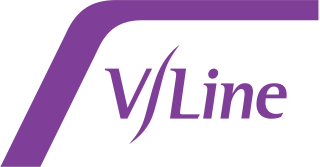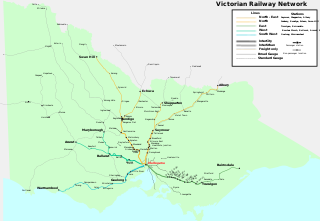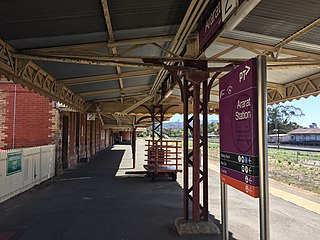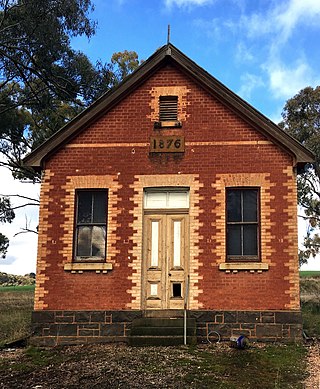Related Research Articles

V/Line is a statutory authority that operates regional passenger train and coach services in the Australian state of Victoria. It provides passenger train services on five commuter lines and eight long-distance routes from its major hub at Southern Cross railway station in Melbourne. It also provides bus services across Victoria and into New South Wales, the Australian Capital Territory and South Australia. In addition, V/Line is responsible for the maintenance of much of the Victorian freight and passenger rail network outside of the areas managed by Metro Trains Melbourne and the Australian Rail Track Corporation.

Rail transport in the Australian state of Victoria is provided by a number of railway operators who operate over the government-owned railway lines. The network consists of 2,357 km of Victorian broad gauge lines, and 1,912 km of standard gauge freight and interstate lines; the latter increasing with gauge conversion of the former. Historically, a few experimental 762 mm gauge lines were built, along with various private logging, mining and industrial railways. The rail network radiates from the state capital, Melbourne, with main interstate links to Sydney and to Adelaide, as well as major lines running to regional centres, upgraded as part of the Regional Fast Rail project.

Maryborough is a town in Victoria, Australia, on the Pyrenees Highway, 58 kilometres (36 mi) north of Ballarat and 168 kilometres (104 mi) northwest of Melbourne, in the Shire of Central Goldfields. At the 2021 census, the urban centre had a population of 7,769., while the larger Level 2 Statistical Area which includes the urban fringe, had 8,160, both an increase of more than 3% since 2016.
The Serviceton railway line is part of the Melbourne–Adelaide rail corridor. It serves the west of Victoria, linking the state capital of Melbourne to the cities of Ballarat and Ararat. It once extended to the disputed South Australian border as part of the Melbourne–Adelaide railway. The former broad-gauge track was replaced in 1995 by the 1435 mm Western standard gauge line.

Ararat railway station is located on the Serviceton and Western standard gauge lines in Victoria, Australia. It serves the town of Ararat, and opened on 7 April 1875.

Maryborough railway station is located on the Mildura line in Victoria, Australia. It serves the town of Maryborough, and it opened on 7 July 1874.
The Mildura railway line is a heavy rail line in northwestern Victoria, Australia. The line runs from Yelta station to Ballarat station via the settlements of Mildura, Ouyen and Maryborough in an approximate south-southeasterly direction. Initial sections of the line opened from Ballarat in 1874 and the line reached Mildura in 1903.

Bung Bong is a locality in Victoria between the towns of Avoca and Maryborough. The locality is divided, with the Western section in the Pyrenees Shire and the Eastern section in Shire of Central Goldfields. The Bet Bet Creek runs towards the north through the middle of the locality and then into the Loddon River. Bung Bong is located on the Pyrenees Highway.
The Western standard gauge railway line is a standard-gauge railway line in western Victoria, Australia. Completed in 1995, it forms part of the Melbourne–Adelaide rail corridor and serves as the principal interstate rail link between Victoria and the western states. The line replaced a number of former broad gauge routes which were gauge converted, and today sees both intrastate and interstate freight traffic, as well as the twice weekly The Overland passenger service. Major towns on the route include Geelong, Ararat, Horsham and Dimboola.

The Robinvale railway line is a freight only country railway line in north-western Victoria, Australia. The line branches from the Mildura line at Dunolly, and at Inglewood the Eaglehawk – Inglewood line connects with the Piangil line outside Bendigo. The parallel Kulwin line junctions from the Robinvale line at Korong Vale then continues northward.

The Melbourne–Adelaide rail corridor consists of the 828-kilometre (514-mile) long 1435 mm standard-gauge main line between the Australian state capitals of Melbourne, Victoria and Adelaide, South Australia, and the lines immediately connected to it. Most of its traffic is freight; the only passenger train along the entire route is the twice-weekly passenger service The Overland, operated by Journey Beyond.
The Geelong–Ballarat railway line is a broad-gauge railway in western Victoria, Australia between the cities of Geelong and Ballarat. Towns on the route include Bannockburn, Lethbridge, Meredith, Elaine and Lal Lal. Major traffic includes general freight from the Mildura line, and grain.

The Ballarat V/Line rail service is a regional passenger rail service operated by V/Line in Victoria, Australia. It serves passengers between state capital Melbourne and the regional city of Ballarat. Beyond Wendouree, it becomes the Ararat line and the Maryborough line.

Avoca railway station is a railway station on the Avoca line in the town of Avoca, Victoria. It was first opened on Saturday, 21 October 1876 however was closed for gauge conversion on Friday, 14 April 1995. Again the railway was opened on Sunday, 28 April 1995, then the line was booked out of service on Friday, 21 January 2005. Although no longer in use, Avoca retains a brick station building, platform and goods shed.

The Maryborough–Avoca–Ararat railway is a railway line in western Victoria, Australia. It is one of the few railway lines in the state to have been closed and then reopened. Today it is a standard gauge branch line connecting the Western SG with Bung Bong (ballast) and Dunolly (grain), running through Maryborough station.
The Moolort Line was a cross-country railway line which connected Maryborough and Castlemaine in Victoria, Australia. The line, now defunct, starts in Castlemaine, passes through Campbells Creek, Yapeen, Guildford, Strangways, Newstead, Moolort, and Carisbrook, before joining the Mildura line at Maryborough.

The disused Elmhurst railway station was a rail station in Elmhurst, Victoria, Australia on the Avoca railway line.
Ben Nevis railway station is an abandoned station on the Avoca railway line, a railway line running from Ararat to Avoca and onto Maryborough in the Australian state of Victoria. It also acted as the terminus of the abandoned Navarre railway line to Navarre, a community in the Wimmera region of Victoria, which was closed in 1954.
References
- ↑ Mills, John (July 2006). The Myth of the Standard Gauge: Rail Gauge Choice in Australia 1850 – 1901 (PDF) (PhD thesis). Griffith University. p. 187. Archived (PDF) from the original on 17 March 2017. Retrieved 18 January 2018.
- ↑ "Transport, Communication and Travel". Year Book Australia, 1967 (PDF). Australian Bureau of Statistics. 1967. pp. 440–445. Archived (PDF) from the original on 8 July 2018. Retrieved 18 January 2018.
- ↑ Carter, Mark (27 July 2015). "20 years on; A pair of interstate milestones – Rail Express". Rail Express. Archived from the original on 26 April 2018. Retrieved 19 January 2018.
- ↑ "Rail Gauge Standardisation Project". Results of special audits and other investigations (PDF). Auditor General Victoria. August 2006. pp. 95–102. Retrieved 19 January 2018.
- ↑ Kingsley, Terri-Anne (16 April 2007). "Rail buyback announced". ABC Local. Archived from the original on 4 April 2017. Retrieved 19 January 2018.
- ↑ Murray Basin Rail Project (PDF). Public Transport Victoria. 2014. p. 2. Archived (PDF) from the original on 27 January 2018. Retrieved 19 January 2018.
- ↑ "Victorian government outlines rail modernisation plans". The Age. Australian Associated Press. 3 May 2014. Archived from the original on 10 September 2014. Retrieved 19 January 2018.
- ↑ King, Charlotte (13 May 2014). "Confused messages over passenger rail". ABC Mildura-Swan Hill. Retrieved 19 January 2018.
- ↑ "Victorian Government sells Rural Finance Corporation". ABC News. 5 May 2014. Archived from the original on 1 November 2016. Retrieved 19 January 2018.
- ↑ Pollock, Michael (17 August 2015). "Murray Basin project tracking". The Courier. Archived from the original on 15 December 2015. Retrieved 19 January 2018.
- ↑ Beilharz, Nikolai (26 August 2015). "Victorian rail project faces funding challenge". ABC Rural. Archived from the original on 20 November 2017. Retrieved 19 January 2018.
- ↑ Brown, Emma (8 April 2016). "Federal Government announces $220 million for Murray Basin Rail project". ABC Rural. Archived from the original on 3 February 2018. Retrieved 19 January 2018.
- ↑ PTV 2014, p. 3.
- ↑ "Warning on Victoria fast rail sleeper choice – Rail Express". Rail Express. 3 March 2003. Retrieved 24 January 2018.
- 1 2 3 4 PTV 2014, p. 4.
- ↑ PTV 2014, p. 5.
- ↑ "Murray Basin Rail Project, Victoria - Railway Technology". Railway Technology. Archived from the original on 9 June 2017. Retrieved 24 January 2018.
- 1 2 3 "Murray Basin gauge conversion contract awarded". Railway Gazette. 27 June 2017. Archived from the original on 1 February 2018. Retrieved 19 January 2018.
- ↑ Probert, Oliver. "Murray Basin rail works progressing". Rail Express. Archived from the original on 23 April 2017. Retrieved 27 January 2018.
- 1 2 Probert, Oliver (1 August 2017). "Murray Basin upgrades begin". Rail Express. Archived from the original on 21 January 2021. Retrieved 26 January 2018.
- ↑ Carey, Adam (24 October 2017). "Rail project worker crushed to death in near Mildura". The Age. Archived from the original on 29 January 2018. Retrieved 19 January 2018.
- ↑ Jacks, Timna (26 October 2017). "Rail death followed warnings about poor safety, union claims". The Age. Archived from the original on 28 November 2017. Retrieved 19 January 2018.
- ↑ Martinich, Rex (20 November 2017). "Major rail project opens Ararat-Maryborough rail line | Photos". The Ararat Advertiser. Archived from the original on 29 January 2018. Retrieved 29 January 2018.
- ↑ Steed, Lachy (16 January 2018). "Freight trains set to return by the end of the month". The Maryborough District Advertiser. Archived from the original on 29 January 2018. Retrieved 19 January 2018.
- ↑ Martinich, Rex (29 January 2018). "Ararat rail line reopened after years of decay". The Ararat Advertiser. Archived from the original on 29 January 2018. Retrieved 29 January 2018.
- ↑ DiFabrizio, Michael (3 February 2018). "Opening of freight line connection delayed". Sunraysia Daily. Archived from the original on 8 February 2018. Retrieved 8 February 2018.
- ↑ DiFabrizio, Michael (14 February 2018). "Birchip stretch in train". Sunraysia Daily. Archived from the original on 13 February 2018. Retrieved 18 February 2018.
- ↑ Cavallaro, Natalie (28 February 2018). "Freight gets back on the rails". Sunraysia Daily. Archived from the original on 27 February 2018. Retrieved 27 February 2018.
- ↑ "First freight train for restored Maryborough-Ararat line | Videos". The Ararat Advertiser. 28 February 2018. Archived from the original on 5 March 2018. Retrieved 4 March 2018.
- 1 2 3 "Murray Basin Rail Project". V/Line Corporation. Archived from the original on 27 March 2018. Retrieved 26 January 2018.
- ↑ Cavallaro, Natalie (30 May 2018). "Nationals slam Labor for putting brakes on Murray Basin Rail Project". Sunraysia Daily. Archived from the original on 14 June 2018. Retrieved 1 June 2018.
- ↑ Hunt, Peter (15 June 2018). "Murray Basin Rail upgrade taken out of V/Line's hands". The Weekly Times. Retrieved 23 June 2018.
- ↑ Martinich, Rex (28 June 2018). "Push for new Ararat rail projects but current work hit by complaints". The Ararat Advertiser. Archived from the original on 20 February 2019. Retrieved 19 February 2019.
- ↑ Wrigley, Brendan (27 June 2018). "State to splash $130 million to separate passenger and freight trains in town". The Courier. Archived from the original on 20 February 2019. Retrieved 19 February 2019.
- ↑ "Murray Basin Rail Project". Victorian Government. Retrieved 19 May 2024.
- 1 2 "Murray Basin Rail Project needs $244 million to get back on track, but it drops crucial standardised gauge". ABC News. 20 October 2020. Retrieved 19 May 2024.
- 1 2 "Victoria to press for Murray Basin rail project lifeline after budget 'disappointment'". The Age. 7 October 2020. Retrieved 19 May 2024.
- ↑ "Federal Government commits additional $200 million to troubled Victorian rail freight project". ABC News. 16 December 2020. Retrieved 19 May 2024.
- ↑ "Building A Better Murray Basin Rail Network". Premier of Victoria. 15 February 2021. Retrieved 19 May 2024.
- ↑ "Work resumes on revised Murray Basin project". International Rail Journal. 18 February 2021. Retrieved 19 May 2024.
- ↑ Hinchliffe, Joseph (17 August 2015). "$416 million freight rail upgrade". Bendigo Advertiser. Archived from the original on 30 April 2016. Retrieved 26 January 2018.
- ↑ Hollingworth, Kellie; Peck, Damien (2 August 2017). "Murray Basin rail upgrades aid farmers, industry". ABC Rural. Archived from the original on 9 January 2018. Retrieved 26 January 2018.
- ↑ "Infrastructure Australia positively assesses Melbourne Metro and Murray Basin Rail business cases". Infrastructure Australia. 20 January 2017. Archived from the original on 11 March 2018. Retrieved 27 January 2018.
- ↑ Miller, Andrew (13 March 2017). "V/Line defends its Murray rail progress". Stock & Land. Archived from the original on 27 January 2018. Retrieved 26 January 2018.
- ↑ Pollock, Michael (21 December 2016). "Push for Murray Basin track change". The Courier. Archived from the original on 26 December 2016. Retrieved 26 January 2018.